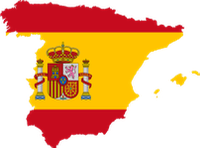
Wines of Spain
Learning the wines of Spain could take a lifetime and what a life it would be. Spain being a peninsula with the Pyrenees to the north along the French border, the Atlantic to the west, and the Mediterranean to the east and south with influential rivers and high, arid lands in the country’s center.
Spanish wines have changed significantly in the past few decades. Once the reds and whites of Spain could be counted on to show significant barrel influences with tart fruits and dry, somewhat oxidized notes, herbs, and cigar box aromas and flavors that delighted some wine lovers and confused others. Clearly the tastes of wine drinkers have changed and one cannot fault wine makers for rushing to make what their customers want. However, can’t we hold on to a handful of the old-style wines? Where do the new wine makers go when they grow and seek wines with unique flavors?
Today there are many different styles of Spanish wines with most reds now being made in a fruit-forward, “international style”. The old guard wines are getting harder to find. For wine drinkers most comfortable with New World style wines the new breed of Spanish wines will seem more accommodating than many of the wines from France or Italy.
Spanish wines, like the French and Italians (and much of Europe), have a regulating body that determines the grape varietals used, the types of wines produced, and other factors within a given district.
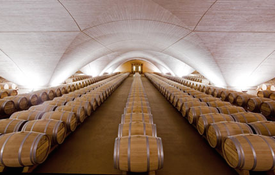
Spain Offers Wine & Beauty
In Spain their regulations fall under the Denominación de Origen (DO), which is the equivalent of an Appellation d’Origine Contrôlée (AOC) in France. Spain’s top category is the Denominación de Origen Calificada (DOC or DOCa or DOQ). Don’t worry too much about this as there are only two DOC: Rioja and Priorat. The vast majority of Spanish wines fall into the DO category and will be labeled with their DO name such as Montsant or Rías Baixas.
Like France and Italy a Spanish wine label will frequently give you just the name of the DO on the front label and no varietal information. However, if the grape is not indicated on the front label it can often be found on the back label. The inclusion of grape names is helpful to the consumer (and somewhat necessary) as most DO offer a range of permitted varietals and without the grape varietal name on the label we would be lost.
Another very useful practice in winemaking and labeling is the cellaring information provided. You will often see the terms Joven, Crianza, Reserva, or Gran Reserva. The span of time required in both barrel and bottle before release is determined by each DO. In all cases Joven will be the youngest wines and these may not spend any time in wood while Gran Reserva is the oldest with red wines being aged in cask for at least 18 months and typically not released until five years after the vintage (harvest).
While it’s no guarantee of quality (the DO and well-reputed brand is a better quality indicator) Reserva and Gran Reserva wines are often at the top of the quality pyramid. The sheer fact that the producer has reserved these wines for extended aging and a later release indicates a certain level of confidence. These wines can also be great values when compared to the other great wines of Europe. You can still find Gran Reserva wines, especially from Rioja, sold in the $20-25 range. Try finding a five to 10-year-old Napa Cabernet or Bordeaux for $25.
Seven Spanish Wine Regions
Green Spain, with the state of Galicia at its heart, is located in the northwest corner of the nation. Fishing and agriculture are king here but not far behind is the region’s must famous DO, Rías Baixas and its most famous wine, Albariño. Albariño became the darling of sommeliers and wine merchants two decades ago and the appeal has never faded. Customarily Albariño is best enjoyed young – look for wines that are two years from the vintage. Albariño is typically floral with crisp fruit flavors redolent of green apples, peach, and citrus while some richer versions offer apricot and some tropical notes. In addition to their vibrant, fresh flavors Albariño made a name for being cheap and cheerful. Like most things it’s not as cheap these days but many can be found for under $20. An interesting fact – more than half of Rías Baixas winemakers are women!
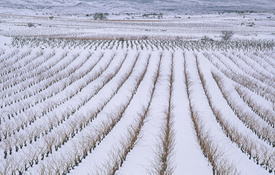
Spanish Wines in Snow
Castilla y Leon, or the Duero River Valley, is located in north central Spain. Its most celebrated DO is Ribera del Duero that follows the Duero River at respectable elevations. The Duero River travels 460 miles and helps create the border with Portugal. This region is the home to old Spanish nobility who kept a foothold here while much of the nation’s southern districts were ruled by the Moors. It’s also home to one of Spain’s most famous and expensive wines, Vega Sicilia.
Luckily there are also many moderately priced wines and considering the overall quality found in this DO you tend to get more for your money than you would in many other prestigious European appellations. Like in Rioja, the reds (primarily red wines made here) are crafted with Tempranillo with Garnacha and Cabernet Sauvignon in support. The best wines from Ribera del Duero are complex and bold with the ability to age gracefully for a decade or more.
The Ebro River Valley is dominated by the nation’s most famous wine region, Rioja. Rioja is located just south of the east-west stretching Cantabrian Mountains in northern Spain. While much of the buzz about Spanish wines over the past decade plus has been about the new or rediscovered appellations, Rioja is still the ambassador of Spanish wine.
The old style of earthy and oxidative wines are still found although this style is rapidly disappearing in favor of sleeker, fruit oriented wines with silky French oak. Now more than ever before red wines are king and Tempranillo is frequently the grape of choice with Garnacha (Grenache), Mazuelo, and Graciano playing important supporting roles.
The traditional aging terms (Crianza, Reserva, or Gran Reserva as discussed earlier) are of great importance in Rioja today as they always have been. While Crianza wines are always aged for two years, Rioja insists that one of these years be spent in oak as opposed to six months in much of Spain. Reserva wines are to be aged for three years with one year in oak. The top of the scale is Gran Reserva; these wines are aged for five years with a minimum of two years in oak.
The Whites from Rioja have seen the greatest transformation as they are lighter and fresher these days being made primarily with Viura. Extended oak aging for whites is a rarity.
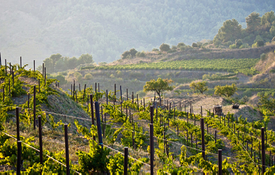
The Beautiful Vineyards in Coastal Spain
The Mediterranean Coast region is vast and offers some great and intriguing wines. Catalonia, located in the far northeastern corner of the Iberian Peninsula dominates the north coast while Murcia and Albacete are the most important wine regions in the southern coastal zone.
Catalonia is virtually a nation of its own with frequent talks of succession further emphasizing that point. Wine has been part of Catalonia’s ancient history for more than 2,300 years. Tarraco, now Tarragona, was the Iberian capital city within the Roman Empire. Grapes were grown in terraces that exist to this day very near to modern DOQ Priorat. There are 12 DO in Catalonia with none more important than Cava.
Cava is Spain’s sparkling wine. Like Champagne, it’s made in the laborious Traditional Method that employs a natural secondary fermentation in the bottle. Despite the similarity of process Cava is much less expensive than Champagne and much more in line with Prosecco prices while Prosecco is made in a bulk method that adds bubbles to an entire tank of wine prior to bottling. Cava can be made in eight of Spain’s wine regions while well over 90% is made in the Catalonian DO of Penedès.
Chief among Catalonia’s reds is Priorat. Priorat is one of the two wines awarded the top designation of DOQ (DOC). The wines are big and bold and made primarily with Garnacha with an important portion of Cariñena (known as Carignan in France). As Priorat is rather small and it has the highest status, the wines can be expensive. Luckily the neighboring DO of Montsant produces wines with great similarity to Priorat at half the price.
In the southern reaches of The Mediterranean Coast Jumilla is the most active and promising DO. Red wines are king here with Monastrell being the most significant grape as it represents over 85% of the vines planted. The wines are fruity while sturdy and often complex. For the time being the wines from Jumilla are often great values so grab them up.
The Mesta, despite being home to nearly two-thirds of Spain’s vineyards, is scarcely known outside of the Iberian Peninsula. Changes to the region are occurring at a dizzying pace. Airén remains the most widely planted grape, at over 70 percent of the vineyards. The are many DOs in this hot and arid zone. The regions of Extremadura and La Mancha hold the greatest promise.
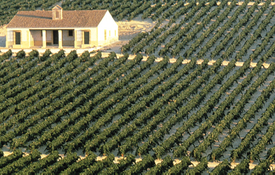
We Can’t Imagine a World Without Sherry
Andalucia is the home of Sherry is one of the world’s three (with Port and Madeira) great fortified wines and geographically covers essentially the entire southern border of Spain. Sherry comes in a wide range of styles from pale straw colored and bone-dry to rich and viscous sweet brown nectar. There are two fundamental types of Sherry, Fino and Oloroso, from which many variations have spawned. The primary difference of these two basic types is the “flor.” Flor is a yeasty film that develops spontaneously on the surface of the wine and guards it from oxidation while contributing unique flavors. Frequently, the first pressing of lighter and more delicate juice is destined to become Fino. After the dry white wine is made it is placed in casks filled to approximately 90%, allowing space for the flor to develop. Subsequent pressing of more robust juice is vinified (made into wine), immediately fortified with neutral grape spirit, and placed in casks to begin the long aging process to become Oloroso. Stylistically in the center is Amontillado, simply an aged Fino. Classic Amontillados are created by allowing the flor to die and sink. This process can take up to a decade and creates Amontillados with great depth and complexity. Pedro Ximénez (aka PX) is named for its single grape variety. This style is unique as the grape are dried in the hot sun concentrating the juice creating a sweet and thick dessert style Sherry.
The Islands of Spain offer a nice variety of wines. The Balearics has a small but growing number of producers and The Canaries with its high peaks is growing as well. The best way to experience these wines is as a tourist to the region as few wines are exported and fewer still make it to the USA.
Spain offers unique wine flavors that pair beautifully with food. There is so much to discover and wines to satisfy every budget. Start your exploration of Spain today from the comfort of your own dining room.
